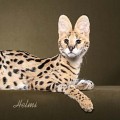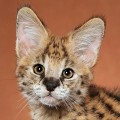
Photo above of Morpheus by Michael. He lives at A1 Savannahs, OK, USA and is a breeding male serval whose role is to create more servals for sale. His mate is Penelope.
These are thumbnails – all are copyright Helmi Flick
– please respect copyright
Overview of Serval as a Wild Cat
See the links above for detail of specific topics on the serval. The serval is abundant in sub-Saharan Africa and therefore there appears to be little concern about its survival as a species. However in north Africa it is almost extirpated.
This is a solitary, long legged, lean cat with a small head and a bite that is subsequently relatively weak and designed for killing small prey, such as rodents.
It has its own specialized way of hunting and killing prey: long waits listening with its large and sensitive ears, a short stalk, then a high pounce to stun and then kill.
It will eat rodents whole, immediately when caught and killed. Big birds are plucked while small ones are swallowed whole.
Its favorite habitat is grassland watered by permanent water courses. There is a higher congregation of rodents in such habitat plus frogs and fish – it can fish too, using its long legs, finger-like toes and sharp claws.
It can raise about 16 – 20 kittens when living in the wild during its lifetime. Its scientific name is Leptailurus serval.
Introduction – as a domestic cat
This section is primarily about this wildcat being domesticated. Wild cat details to follow shortly (Aug. 2010).
This is a medium sized African wildcat and it can be a domestic cat, albeit quite rare; but not as rare on my reckoning as some other domestic cat breeds (see rare cat breeds). This cat has been domesticated and bred, primarily in the USA. They can be tame wild cats but the keeping of them presents a wide range of differences to that of caretaking a true domestic cat. The Times Newspaper (UK) reported on a case of a tame serval that had accompanied the “owner” to a central London restaurant. The date was November 12th 1923. So, you can see that domestication of this cat is not a recent idea. Read more about this story.
Very strong bonds can be forged between a tame wild animal and humans. Note, though, that although this is a medium sized wild cat, this cat is a very large domestic cat (25-40 lbs compared with 7-11 lbs for a domestic cat – go to a comparison chart on domestic cat size). You can make a comparison between this cat and the Savannah in the photograph below. And get a feel for size in the second video down on this page of a wonderful serval playing with the Flicks and me (a still photo in the video).
I have been in an enclosure with domesticated servals, male and female and they can be intimating. You need a certain amount of confidence. As a domestic cat it will suit very few people.
The Savannah cat is a domestic cat/Serval hybrid and a big cat in its own right (the biggest registered purely domestic cat). Yet, in the photograph below, you can see that the Savannah is very much smaller than her wild relative. As a person who adopts this cat you will be in part responsible for taming it and in doing so you take away from the cat its natural ability to provide for itself. The becomes dependent on the “owner”. There is I think therefore an added responsibility to care for such a serval throughout his or her life. Sadly there are a number of example where this has not taken place. See for example: Serval Escapes.
In the Savanna habitat this cat’s diet is mainly small animals such as rodents and includes insects, birds, fish, reptiles and occasionally larger animals such as small antelope. This needs to be kept in mind when considering the kind of diet that you will be providing (see below). However, a raw cat food diet would seem to not be obligatory.
The scientific name for this cat is Leptailurus serval.





